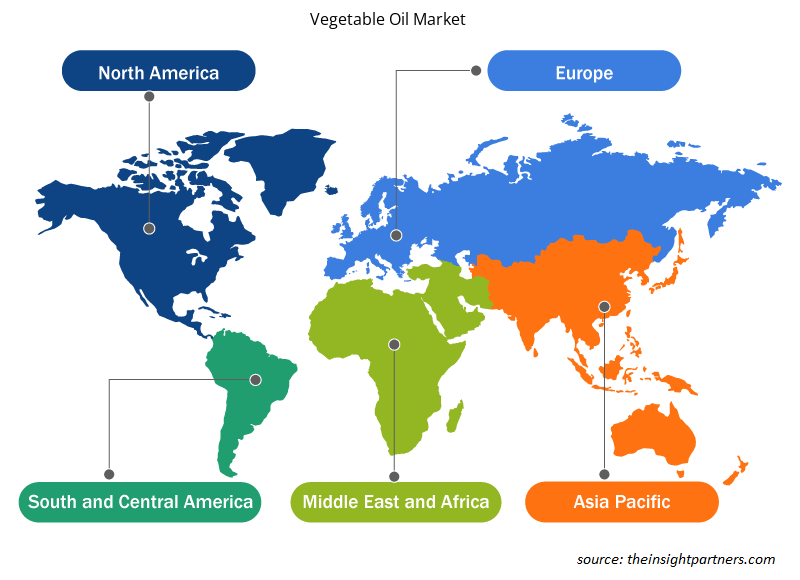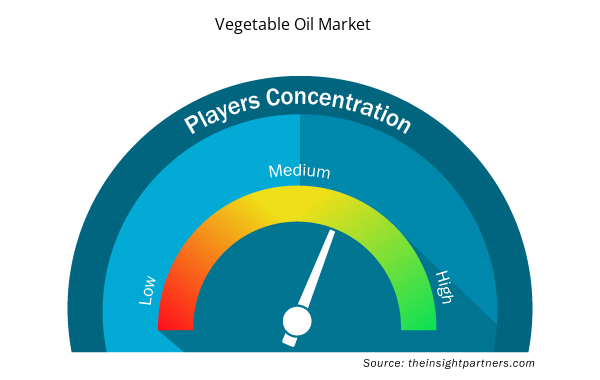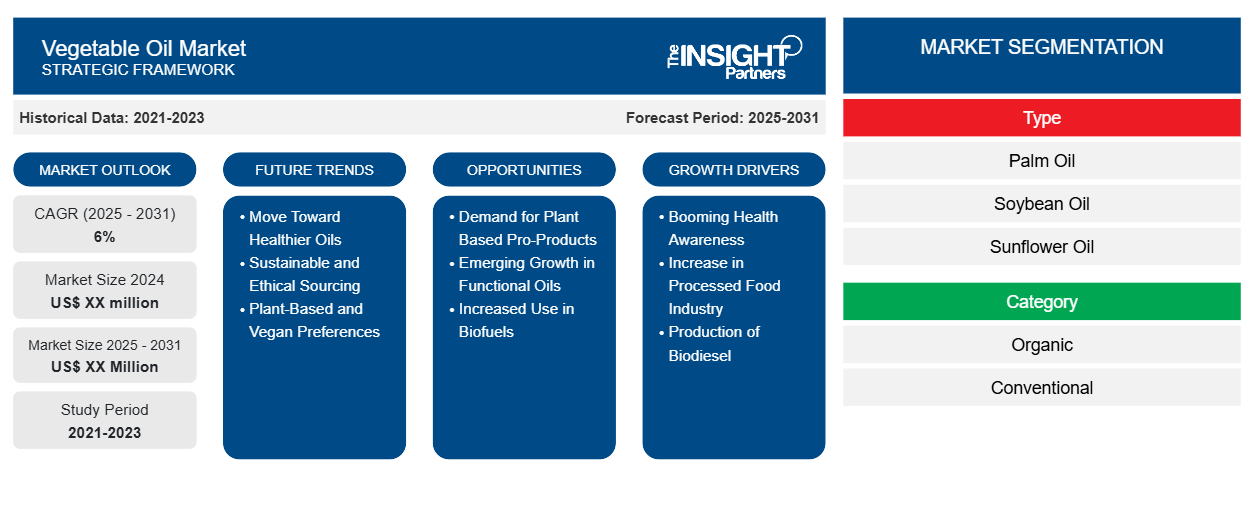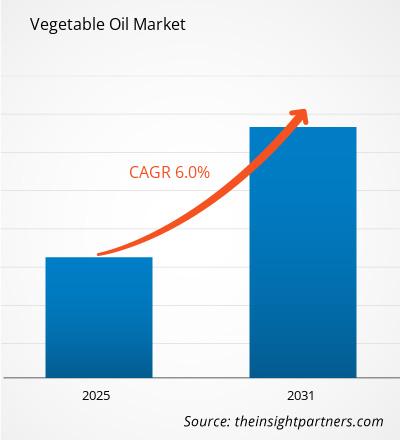Se espera que el mercado de aceite vegetal registre una CAGR del 6% entre 2023 y 2031, con un tamaño de mercado que se expandirá de US$ XX millones en 2023 a US$ XX millones en 2031.
El informe está segmentado por tipo (aceite de palma, aceite de soja, aceite de girasol, aceite de oliva, aceite de coco, otros), categoría (orgánico, convencional). El informe presenta además un análisis basado en el canal de distribución (supermercados e hipermercados, tiendas de conveniencia, venta minorista en línea y otros). El análisis global se desglosa aún más a nivel regional y por países principales. En términos geográficos, el mercado se divide en América del Norte, Europa, Asia Pacífico, Oriente Medio y África, y América del Sur y Central. El informe ofrece el valor en USD para el análisis y los segmentos anteriores.
Propósito del Informe
El informe Vegetable Oil Market de The Insight Partners tiene como objetivo describir el panorama actual y el crecimiento futuro, los principales factores impulsores, los desafíos y las oportunidades. Esto proporcionará información a diversas partes interesadas del negocio, como:
- Proveedores/fabricantes de tecnología: Para comprender la dinámica cambiante del mercado y conocer las oportunidades potenciales de crecimiento, lo que les permitirá tomar decisiones estratégicas informadas.
- Inversionistas: Realizar un análisis exhaustivo de tendencias sobre la tasa de crecimiento del mercado, las proyecciones financieras del mercado y las oportunidades que existen en toda la cadena de valor.
- Órganos reguladores: Regular las políticas y vigilar las actividades del mercado con el objetivo de minimizar los abusos, preservar la confianza de los inversores y defender la integridad y la estabilidad del mercado.
Segmentación del mercado de aceites vegetales
Tipo
- Aceite de palma
- Aceite de soja
- Aceite de girasol
- Aceite de oliva
- Aceite de coco
- Otros
Categoría
- Orgánico
- Convencional
Canal de distribución
- Supermercados e Hipermercados
- Tiendas de conveniencia
- Venta minorista en línea
- Otros
Geografía
- América del norte
- Europa
- Asia-Pacífico
- América del Sur y Central
- Oriente Medio y África
Geografía
- América del norte
- Europa
- Asia-Pacífico
- América del Sur y Central
- Oriente Medio y África
Personalice este informe según sus necesidades
Obtendrá personalización en cualquier informe, sin cargo, incluidas partes de este informe o análisis a nivel de país, paquete de datos de Excel, así como también grandes ofertas y descuentos para empresas emergentes y universidades.
- Obtenga las principales tendencias clave del mercado de este informe.Esta muestra GRATUITA incluirá análisis de datos, desde tendencias del mercado hasta estimaciones y pronósticos.
Factores impulsores del crecimiento del mercado de aceites vegetales
- Aumento de la conciencia sobre la salud: los consumidores son cada vez más conscientes de la salud y aumenta la demanda de tipos de aceites vegetales como los ácidos grasos saludables, como el aceite de oliva y el de canola. Se cree que estos aceites favorecen una dieta saludable para el corazón al sustituir las grasas animales, lo que impulsa el desarrollo del mercado de los aceites vegetales.
- Aumento de la industria de alimentos procesados: La industria de alimentos procesados y envasados ha aumentado la demanda de aceites vegetales. Estos aceites se utilizarán para cocinar, freír y más, como aperitivos, comidas preparadas y productos horneados, lo que dará lugar a un mayor crecimiento del sector.
- Producción de biodiésel: La creciente tendencia a utilizar aceites vegetales para la producción de biodiésel ha contribuido de manera significativa a la expansión del mercado. La tendencia hacia fuentes de energía renovables y combustibles más limpios iniciada por los gobiernos ha impulsado el uso de aceites vegetales para la fabricación de biocombustibles, extendiendo así su aplicación más allá del uso alimentario; por ejemplo, el biodiésel a partir de aceites de soja y de palma.
Tendencias futuras del mercado de aceites vegetales
- Opte por aceites más saludables: existe una tendencia cada vez mayor hacia la adopción de grasas como el aceite de aguacate, de oliva y de linaza. En la actualidad, los consumidores prefieren aceites con bajas cantidades de grasas saturadas y altas cantidades de ácidos grasos omega-3, consumiéndolos por preocupación por la salud y por concienciar sobre la salud cardiovascular.
- Abastecimiento sostenible y ético: a medida que los consumidores se inclinan por productos de origen cada vez más sostenible y ético, la industria del aceite vegetal está pasando a la producción sostenible de aceite de palma y su certificación (a la RSPO) ahora incluye prácticas respetuosas con el medio ambiente para los consumidores. Esta tendencia da como resultado una zona menos deforestada y unas mejores condiciones ambientales para la plantación de aceite.
- Preferencias de origen vegetal y veganas: la creciente preferencia por los alimentos de origen vegetal que impulsan el negocio de los aceites vegetales también incluye categorías de origen vegetal y veganas. Algunos ejemplos son los aceites de coco, canola y soja, que han sido elegidos principalmente por veganos y vegetarianos para cocinar, hornear o preparar alimentos.
Oportunidades de mercado para el aceite vegetal
- Demanda de productos profesionales de origen vegetal: Muy populares a medida que crece la demanda de la industria, las oportunidades particulares de compartir aceites vegetales como aguacate, girasol y canola se convierten en actores principales en la línea de productos alimenticios veganos y de origen vegetal.
- Crecimiento emergente de los aceites funcionales: esto revela una oportunidad en el mercado de los aceites vegetales, ya que se demandan aceites funcionales con beneficios adicionales para la salud. Los aceites enriquecidos con ácidos grasos omega-3, antioxidantes y vitaminas han ganado popularidad debido a sus beneficios percibidos para la salud, como la reducción de la inflamación y la mejora de la salud cardíaca.
- Mayor uso de biocombustibles: con el creciente interés por las fuentes de energía renovables, los aceites vegetales ocupan un lugar destacado en la producción de biocombustibles. Por lo tanto, los productores de aceite pueden aspirar a ampliar sus mercados, suministrar aceites como los de soja y palma para biocombustibles y alcanzar objetivos de sostenibilidad en el sector energético.
Perspectivas regionales del mercado de aceite vegetal
Los analistas de Insight Partners explicaron en detalle las tendencias y los factores regionales que influyen en el mercado de aceite vegetal durante el período de pronóstico. Esta sección también analiza los segmentos y la geografía del mercado de aceite vegetal en América del Norte, Europa, Asia Pacífico, Oriente Medio y África, y América del Sur y Central.

- Obtenga los datos regionales específicos para el mercado de aceite vegetal
Alcance del informe sobre el mercado de aceites vegetales
| Atributo del informe | Detalles |
|---|---|
| Tamaño del mercado en 2023 | XX millones de dólares estadounidenses |
| Tamaño del mercado en 2031 | US$ XX millones |
| CAGR global (2023 - 2031) | 6% |
| Datos históricos | 2021-2022 |
| Período de pronóstico | 2024-2031 |
| Segmentos cubiertos | Por tipo
|
| Regiones y países cubiertos | América del norte
|
| Líderes del mercado y perfiles de empresas clave |
|
Densidad de actores del mercado de aceite vegetal: comprensión de su impacto en la dinámica empresarial
El mercado de aceites vegetales está creciendo rápidamente, impulsado por la creciente demanda de los usuarios finales debido a factores como la evolución de las preferencias de los consumidores, los avances tecnológicos y una mayor conciencia de los beneficios del producto. A medida que aumenta la demanda, las empresas amplían sus ofertas, innovan para satisfacer las necesidades de los consumidores y aprovechan las tendencias emergentes, lo que impulsa aún más el crecimiento del mercado.
La densidad de actores del mercado se refiere a la distribución de las empresas o firmas que operan dentro de un mercado o industria en particular. Indica cuántos competidores (actores del mercado) están presentes en un espacio de mercado determinado en relación con su tamaño o valor total de mercado.
Las principales empresas que operan en el mercado de aceites vegetales son:
- Cargill, Incorporada
- Wilmar Internacional Limitada
- Alimentos B y G, Inc.
- Alimentos e ingredientes de Richardson
- Compañías de alimentos ACH, Inc.
- Recursos agrícolas dorados Ltd.
Descargo de responsabilidad : Las empresas enumeradas anteriormente no están clasificadas en ningún orden particular.

- Obtenga una descripción general de los principales actores clave del mercado de aceites vegetales
Puntos de venta clave
- Cobertura integral: el informe cubre de manera integral el análisis de productos, servicios, tipos y usuarios finales del mercado de aceite vegetal, proporcionando un panorama holístico.
- Análisis de expertos: el informe se compila sobre la base de un profundo conocimiento de expertos y analistas de la industria.
- Información actualizada: El informe asegura relevancia comercial debido a su cobertura de información reciente y tendencias de datos.
- Opciones de personalización: este informe se puede personalizar para satisfacer los requisitos específicos del cliente y adaptarse adecuadamente a las estrategias comerciales.
Por lo tanto, el informe de investigación sobre el mercado de aceites vegetales puede ayudar a abrir camino para descifrar y comprender el escenario de la industria y las perspectivas de crecimiento. Si bien puede haber algunas preocupaciones válidas, los beneficios generales de este informe tienden a superar las desventajas.
- Análisis histórico (2 años), año base, pronóstico (7 años) con CAGR
- Análisis PEST y FODA
- Tamaño del mercado Valor/volumen: global, regional, nacional
- Industria y panorama competitivo
- Conjunto de datos de Excel



Report Coverage
Revenue forecast, Company Analysis, Industry landscape, Growth factors, and Trends

Segment Covered
This text is related
to segments covered.

Regional Scope
North America, Europe, Asia Pacific, Middle East & Africa, South & Central America

Country Scope
This text is related
to country scope.
Preguntas frecuentes
The report can be delivered in PDF/Word format, we can also share excel data sheet based on request.
Based on geography, Asia Pacific held the largest share of the vegetable oil market.
The rising sustainability concern among consumers is likely to remain the key trends in the market.
Cargill, Incorporated, Wilmar International Limited, B and G Foods, Inc., Richardson Food and Ingredients, ACH Food Companies, Inc, Golden Agri-Resources Ltd, Sime Darby Plantation Berhad, La Tourangelle, Conagra Brands, Inc, IFFCO Group are among the leading players operating in the vegetable oil market.
The Vegetable Oil Market is estimated to witness a CAGR of 6% from 2023 to 2031
The rising awareness about benefits of vegetable oil over animal fat and strategic development initiatives by key market players is driving the vegetable oil market growth.
Trends and growth analysis reports related to Food and Beverages : READ MORE..
The List of Companies
1. ACH Foods Company Inc
2. Archer Daniels Midland Company
3. Bunge
4. Cargill, Incorporated
5. CHS Inc.
6. ConAgra Foods, Inc.
7. J-Oil Mills Inc.
8. Olam International
9. Richardson Oilseed Ltd.
10. RISOIL S.A.
The Insight Partners performs research in 4 major stages: Data Collection & Secondary Research, Primary Research, Data Analysis and Data Triangulation & Final Review.
- Data Collection and Secondary Research:
As a market research and consulting firm operating from a decade, we have published and advised several client across the globe. First step for any study will start with an assessment of currently available data and insights from existing reports. Further, historical and current market information is collected from Investor Presentations, Annual Reports, SEC Filings, etc., and other information related to company’s performance and market positioning are gathered from Paid Databases (Factiva, Hoovers, and Reuters) and various other publications available in public domain.
Several associations trade associates, technical forums, institutes, societies and organization are accessed to gain technical as well as market related insights through their publications such as research papers, blogs and press releases related to the studies are referred to get cues about the market. Further, white papers, journals, magazines, and other news articles published in last 3 years are scrutinized and analyzed to understand the current market trends.
- Primary Research:
The primarily interview analysis comprise of data obtained from industry participants interview and answers to survey questions gathered by in-house primary team.
For primary research, interviews are conducted with industry experts/CEOs/Marketing Managers/VPs/Subject Matter Experts from both demand and supply side to get a 360-degree view of the market. The primary team conducts several interviews based on the complexity of the markets to understand the various market trends and dynamics which makes research more credible and precise.
A typical research interview fulfils the following functions:
- Provides first-hand information on the market size, market trends, growth trends, competitive landscape, and outlook
- Validates and strengthens in-house secondary research findings
- Develops the analysis team’s expertise and market understanding
Primary research involves email interactions and telephone interviews for each market, category, segment, and sub-segment across geographies. The participants who typically take part in such a process include, but are not limited to:
- Industry participants: VPs, business development managers, market intelligence managers and national sales managers
- Outside experts: Valuation experts, research analysts and key opinion leaders specializing in the electronics and semiconductor industry.
Below is the breakup of our primary respondents by company, designation, and region:

Once we receive the confirmation from primary research sources or primary respondents, we finalize the base year market estimation and forecast the data as per the macroeconomic and microeconomic factors assessed during data collection.
- Data Analysis:
Once data is validated through both secondary as well as primary respondents, we finalize the market estimations by hypothesis formulation and factor analysis at regional and country level.
- Macro-Economic Factor Analysis:
We analyse macroeconomic indicators such the gross domestic product (GDP), increase in the demand for goods and services across industries, technological advancement, regional economic growth, governmental policies, the influence of COVID-19, PEST analysis, and other aspects. This analysis aids in setting benchmarks for various nations/regions and approximating market splits. Additionally, the general trend of the aforementioned components aid in determining the market's development possibilities.
- Country Level Data:
Various factors that are especially aligned to the country are taken into account to determine the market size for a certain area and country, including the presence of vendors, such as headquarters and offices, the country's GDP, demand patterns, and industry growth. To comprehend the market dynamics for the nation, a number of growth variables, inhibitors, application areas, and current market trends are researched. The aforementioned elements aid in determining the country's overall market's growth potential.
- Company Profile:
The “Table of Contents” is formulated by listing and analyzing more than 25 - 30 companies operating in the market ecosystem across geographies. However, we profile only 10 companies as a standard practice in our syndicate reports. These 10 companies comprise leading, emerging, and regional players. Nonetheless, our analysis is not restricted to the 10 listed companies, we also analyze other companies present in the market to develop a holistic view and understand the prevailing trends. The “Company Profiles” section in the report covers key facts, business description, products & services, financial information, SWOT analysis, and key developments. The financial information presented is extracted from the annual reports and official documents of the publicly listed companies. Upon collecting the information for the sections of respective companies, we verify them via various primary sources and then compile the data in respective company profiles. The company level information helps us in deriving the base number as well as in forecasting the market size.
- Developing Base Number:
Aggregation of sales statistics (2020-2022) and macro-economic factor, and other secondary and primary research insights are utilized to arrive at base number and related market shares for 2022. The data gaps are identified in this step and relevant market data is analyzed, collected from paid primary interviews or databases. On finalizing the base year market size, forecasts are developed on the basis of macro-economic, industry and market growth factors and company level analysis.
- Data Triangulation and Final Review:
The market findings and base year market size calculations are validated from supply as well as demand side. Demand side validations are based on macro-economic factor analysis and benchmarks for respective regions and countries. In case of supply side validations, revenues of major companies are estimated (in case not available) based on industry benchmark, approximate number of employees, product portfolio, and primary interviews revenues are gathered. Further revenue from target product/service segment is assessed to avoid overshooting of market statistics. In case of heavy deviations between supply and demand side values, all thes steps are repeated to achieve synchronization.
We follow an iterative model, wherein we share our research findings with Subject Matter Experts (SME’s) and Key Opinion Leaders (KOLs) until consensus view of the market is not formulated – this model negates any drastic deviation in the opinions of experts. Only validated and universally acceptable research findings are quoted in our reports.
We have important check points that we use to validate our research findings – which we call – data triangulation, where we validate the information, we generate from secondary sources with primary interviews and then we re-validate with our internal data bases and Subject matter experts. This comprehensive model enables us to deliver high quality, reliable data in shortest possible time.


 Obtenga una muestra gratuita de este informe
Obtenga una muestra gratuita de este informe